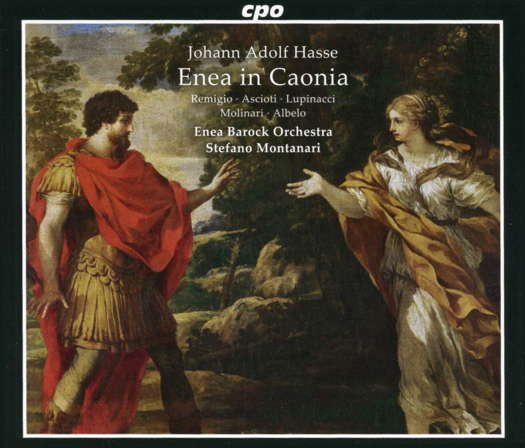- Keiko Takano
- Ahmed Adnan Saygun
- Meyer Kupferman
- prima donna
- Philip Sawyers
- John Blytheman
- Peter Sheppard Skærved
- Evin Ilyasoglu
 DISCUSSION: John Dante Prevedini leads a discussion about Music and the Visual World, including contributions from Celia Craig, Halida Dinova and Yekaterina Lebedeva.
DISCUSSION: John Dante Prevedini leads a discussion about Music and the Visual World, including contributions from Celia Craig, Halida Dinova and Yekaterina Lebedeva.
 SPONSORED: CD Spotlight. An Encyclopedic Recital - Elizabeth Moak plays Judith Lang Zaimont, heard by the late Howard Smith.
SPONSORED: CD Spotlight. An Encyclopedic Recital - Elizabeth Moak plays Judith Lang Zaimont, heard by the late Howard Smith.
All sponsored features >>

A Young Saxon's Occasional Opera
GIUSEPPE PENNISI listens to 'Enea in Caonia' by Hasse
'Stefano Montanari conducts ... skilfully, mostly in support of the voices.'
This is the first recording of Enea in Caonia by Johann Adolf Hasse to a libretto by Silvio Stampiglia and his son Luigi Maria Stampiglia. Historically and philologically it is quite interesting for two reasons: it is a work of transition between a serenata and a baroque opera; and it is the last and most elaborate work Hasse composed during the years when he lived and composed in Naples, where he was nicknamed 'the Saxon'.
A few words on Hasse and his Neapolitan period: Johann Adolph Hasse (baptised 25 March 1699; died 16 December 1783) was an eighteenth-century German composer, singer and teacher of music. Immensely popular in his time, Hasse was best known for his prolific operatic output, though he also composed a considerable quantity of sacred music. Married to soprano Faustina Bordoni and a great friend of librettist Pietro Metastasio, whose libretti he frequently set, Hasse was a pivotal figure in the development of opera seria and eighteenth-century music.
His career began in singing when he joined the Hamburg Oper am Gänsemarkt in 1718 as a tenor. In 1719, he obtained a singing post at the court of Brunswick, where in 1721 his first opera, Antioco, was performed; Hasse himself sang in the production. He is thought to have left Germany during 1722. During the 1720s he lived mostly in Naples, for six or seven years. In 1725 his serenata Marc'antonio e Cleopatra was performed at Naples. The success of this work not only earned Hasse many commissions from Naples' opera houses, but also, according to Johann Joachim Quantz, brought him into contact with Alessandro Scarlatti, who became his teacher and friend; Hasse also altered his style in several respects to reflect that of Scarlatti.
Hasse's popularity in Naples increased dramatically and his workload kept him extremely busy. In this period, he composed his only full opera buffa, La sorella amante, in addition to several intermezzi and serenatas. He visited the Venetian Carnival of 1730, where his opera Artaserse was performed: Metastasio's libretto was heavily reworked for the occasion, and Farinelli took a leading role. Later, Farinelli sang two arias from this opera every night for a decade for Philip V of Spain.
As mentioned above, Enea in Caonia is a transitional work, between a serenata and an opera seria. The serenata was meant to be essentially a court entertainment written to celebrate special occasions, such as weddings and christenings of the high and mighty, or visits by important dignitaries, performed in front of an invited audience. With the decline of the European aristocracy, it lost its role, so that by the early nineteenth century it had become an obsolete form to the extent that, even today, interest in the genre remains marginal. Generally, a serenata has only two voices, such as in Hasse's Marc'Antonio e Cleopatra or La Semele, as well as a very simple libretto with almost no plot. Enea in Caonia is far more ambitious than these two pieces: five singers and a skeleton of a story. It is, nonetheless, an occasional work in the sense that it was a commission for a special occasion: most probably the November 1727 visit to Naples of Violante Beatrice of Bavaria, the daughter of the Elector of Bavaria and the widow of the Grand Prince Ferdinando de Medici of Tuscany. The young 'Saxon' was, no doubt, well-appreciated and well-connected to gain such an important commission.
The plot is elementary for a nearly two hour work. After the destruction of Troy by fire, Æneas sails along the coast of Epirus on his voyage to Italy and enters a local port, Here, he receives news of Andromache and finds her married to Helenus, king of Caonia. Helenus welcomes him with courtesy. Helenus is a seer as well. When Æneas asks about his future, the King depicts him on his travels to the foundation of Rome. This simple plot, involving only three characters, is made more elaborate by the presence of Nisus, comrade-in-arms of Æneas, and their encounter, in a wood, with the Trojan Princess Ilia. She falls in love with Æneas, who steadfastly intends to travel to the New Troy, ie Rome, and abandons her. There are thirty-six musical numbers, alternating between arias and recitatives. The six trios, the six pieces for two voices and the only piece for four voices are all recitatives.
Troy's hero is the well-versed alto Francesca Asciolti. She has impervious arias such as Se qual tu sei qui son si belle and Troia bella distrutta dal fuoco: there is quite good vocalizing but no psychological development as the character she interprets is a steadfastly single-minded heroine. She is very good in descending to a very low register.
Listen — Hasse: Troia bella distrutta dal fuoco (Enea in Caonia, Part 2)
(CD2 track 3, 0:00-0:52) ℗ 2020 Classic Produktion Osnabrück :
Carmela Remigio as Ilia is a suffering soul, especially in her long aria Tu che de' suoi tormenti and her dramatic aria Saper tu vuoi perché.
Listen — Hasse: Saper tu vuoi perché (Enea in Caonia, Part 2)
(CD2 track 19, 1:06-1:41) ℗ 2020 Classic Produktion Osnabrück :
I have been following Carmela Remigio since her 1998 Aix-en-Provence debut in Mozart's Don Giovanni with Claudio Abbado as conductor and Peter Brook as stage director. She a well-versed soprano in a wide range of roles: this album demonstrates how she can still handle early Baroque music well as shown in E' vero che son povera.
Listen — Hasse: E' vero che son povera (Enea in Caonia, Part 1)
(CD1 track 13, 0:34-1:27) ℗ 2020 Classic Produktion Osnabrück :
Helenus is sung by a Baroque music specialist - soprano Paola Valentina Molinari. Often present in the recitatives, she excels in two arias in Part 2 - Biondo nume and Le memoranda imprese.
Listen — Hasse: Le memoranda imprese (Enea in Caonia, Part 2)
(CD2 track 21, 0:00-0:54) ℗ 2020 Classic Produktion Osnabrück :
Andromache is the well-known mezzo Raffaella Lupinacci, who I had previously heard mostly in Puccini and Rossini roles. She is quite enthralling in Spargo rami di fiori e di mirti and in Con lusinghieri accenti.
Listen — Hasse: Con lusinghieri accenti (Enea in Caonia, Part 2)
(CD2 track 15, 0:18-1:14) ℗ 2020 Classic Produktion Osnabrück :
The only male voice in the cast is the coloratura tenor Celso Albelo as Niso. His bravura piece is Ninfa sei che al bosco e al monte.
Listen — Hasse: Ninfa sei che al bosco e al monte (Enea in Caonia, Part 1)
(CD1 track 5, 2:55-3:41) ℗ 2020 Classic Produktion Osnabrück :
The Enea Barock Orchestra is an ensemble created for the revival of this and other forgotten eighteenth century operas. Stefano Montanari conducts it skilfully, mostly in support of the voices.
The CD clearly aims at specialists but can be enjoyed by general audiences as well.
Copyright © 6 February 2022
Giuseppe Pennisi,
Rome, Italy

CD INFORMATION - JOHANN ADOLF HASSE: ENEA IN CAONIA
CLASSICAL MUSIC ARTICLES ABOUT NAPLES


